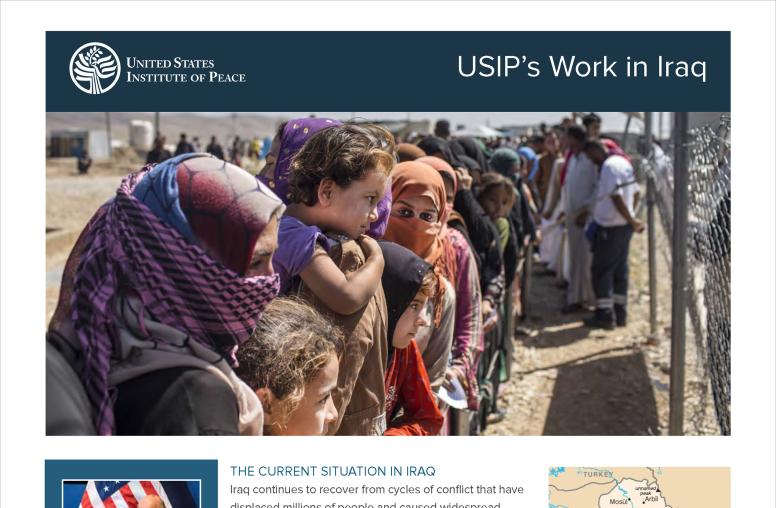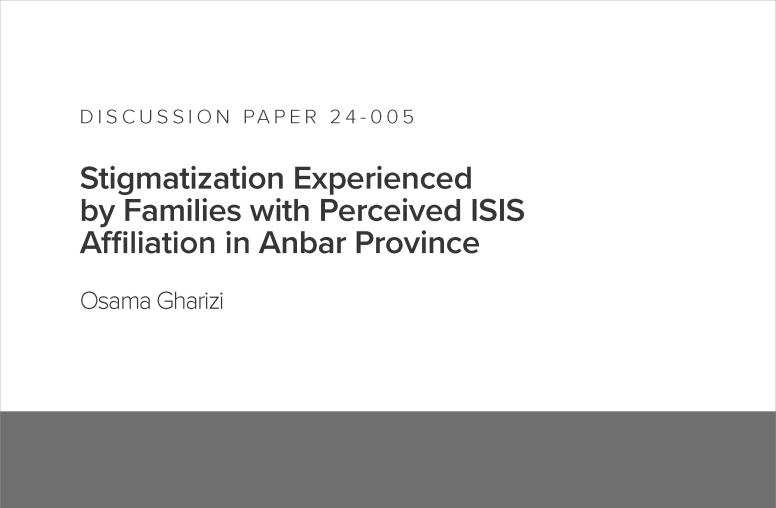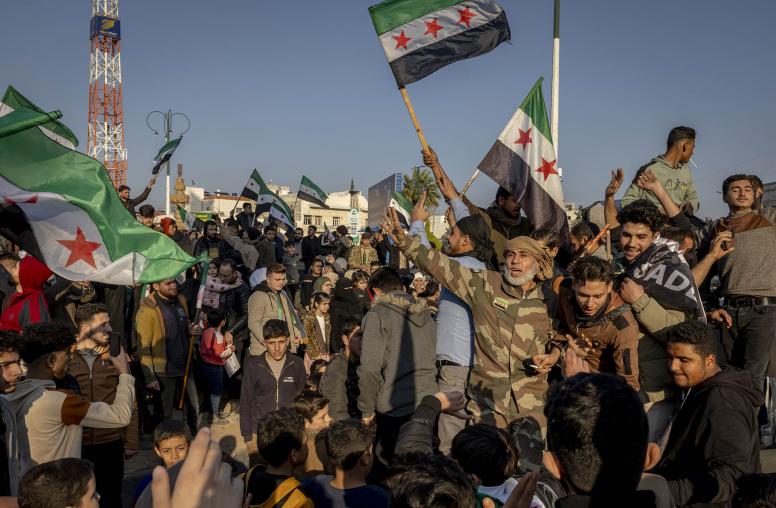A Year After Elections, Iraq May Finally Be Set to Form a Government
The country’s political class now stands at a crossroads: Will it seek to heal the country’s deep divides or go back to business as usual?
Iraq hit two anniversaries this month. Three years ago in October, Iraqis rose up to protest the failure of the Iraqi government and political class in delivering basic services, providing jobs, fighting corruption and more. One of the outcomes of those protests was early elections, which were held on October 10, 2021, but have yet to yield a government. The last year witnessed crippling political gridlock, as the winner of the 2021 national parliamentary elections, Moqtada al-Sadr, eventually withdrew from the political process after failing to form a government.

Last week, Iraq’s parliament elected Abdul Latif Rashid as president, and he then named Mohammed Shia al-Sudani as prime minister-designate. Al-Sudani, who now is tasked with forming a government, is the nominee of the Coordination Framework, al-Sadr’s chief rival. Amid a year of political turmoil and three years after the protests erupted, Iraqis’ grievances remain largely unaddressed.
USIP’s Sarhang Hamasaeed discusses how we got here, what comes next in the government formation process and where Iraq’s protest movement stands three years on.
It’s been a year since the 2021 elections. What is the latest regarding the stalled government formation process?
Iraq held national parliamentary elections on October 10, 2021, but struggled with forming a government for a year. The election resulted in two broad coalitions that led to a state of gridlock over the forming of a government amid controversial litigation in the Federal Supreme Court, drone attacks on Prime Minister Mustafa al-Kadhimi's house, armed attacks on the offices and residence of various political actors, violence in Baghdad’s “Green Zone” and external pressure, particularly from Iran. Al-Sadr, whose bloc won the largest number of seats (73), sought to form a majoritarian government with Sunni Arabs, led by parliament Speaker Mohammed al-Halbousi and Khamis al-Khanjar, and the Kurdistan Democratic Party, led by Massoud Barzani. The Coordination Framework — considered to be Iran-backed — which includes the State of Law alliance of former Prime Minister Nouri al-Maliki, the Fatah Coalition and others, succeeded in blocking al-Sadr.
Over a year later on October 13, Iraq’s parliament voted Abdul Latif Rashid as the new president, who in turn designated Coordination Framework nominee Mohammed Shia al-Sudani as prime minister. Nine rockets hit the vicinity of the parliament and other parts of Baghdad as the voting occurred, but it did not stop the process. With 30 days to form a government and win a vote of confidence from the parliament, al-Sudani is negotiating with other political parties to form his government and projects confidence in his actions and messages. He has also welcomed the Sadrists’ participation in the government, but that’s unlikely to happen.
This breakthrough was made possible because al-Sadr gave up all his bloc’s parliamentary seats and his attempt of applying public pressure through the street — occupying the parliament building and judiciary headquarters — backfired. The Coordination Framework replaced al-Sadr’s MPs with their own, nominated al-Sudani to become prime minister, and reached agreement with Kurdish and Sunni Arab allies of al-Sadr — whom al-Sadr has freed from commitments they made to him — to support their candidate.
The Coordination Framework, which now holds the highest number of Shia seats in the parliament, has come together with most Kurdish and Sunni MPs under a new coalition called the State Administration Coalition (Itilaf Idarat al-Dawla). They have sufficient votes and seem to have established enough foundation for a government to finally form. Regional and international interlocutors, including the United States and European allies, have welcomed the government formation process moving forward. However, there continues to be apprehension about what al-Sadr might do next: Will he challenge the formation of the cabinet? Will he wait until a government is formed and then challenge it? Or will he move on and focus on the next elections?
The Coordination Framework nominated al-Sudani in July, when tensions were particularly high with the Sadrists. The broader Iraqi public was not in favor of the nomination, as it contravened the spirit of elections and democracy for the biggest wining bloc to be out and others who did not win to take their place and form the government. Iran’s support for the Coordination Framework also loomed large. However, since then, al-Sudani has grown on political actors, the international community and, to some extent, the Iraqi public as they learn more about him. He has conveyed messages about forming a capable government that would improve services, protect Iraq’s sovereignty, respond to the protesters’ demands, cooperate regionally and internationally, tackle climate change and address other issues. Some foreign diplomats have met with him already, even before the vote of confidence, a sign that the international community is keen on the government formation moving forward.
While the charisma, resolve and other personal qualities of the prime minister are important, Iraq’s history demonstrates that a mix of factors — the will of the political class, parliament, government bureaucracy and external influence — ultimately determines the success or failure of a prime minister and their government. The political and financial interests of al-Sudani coalition’s members may stymie needed reforms more than Sadrists or other political actors would have. Al-Sudani and the Coordination Framework certainly have an opportunity and responsibility to fulfill their promise of a “government of service” and beyond.
How does this government formation process compare to previous ones in Iraq?
As expected, the government formation was a lengthy and rocky process, breaking Iraq’s own protracted record. Recent developments show that key Shia, Sunni and Kurdish parties will share important ministries and positions of the government, which contravenes what the 2019 protest movement sought to end or at least minimize. Like previous elections, a coalition of different parties will form the government, not a single party that won the highest number of seats.
Al-Sadr sought to form a majoritarian government and stated that he would not have the same outcome of the 2010 elections, where Al-Iraqiya List/Coalition led by former Prime Minister Iyad Allawi had the highest number of seats yet was denied the opportunity to form the government. Like the 2010 government formation process, time was not in favor of the winning bloc. After the 2021 vote, al-Sadr became frustrated and took steps — like making his MPs resign in mass — that proved to be a mistake according to Iraqis and experts. It seems that once again, the international community has become frustrated with the protracted process and is now supporting government formation, even if that means the party who won the most seats is not included. This raises the question again, as it did in 2010, if the international community, including the United States, is coming up short in supporting Iraq’s democracy.
Last year’s elections were the result of the mass protest movement that began in 2019. Three years later, could the lack of progress spark renewed protests? If protests were to reignite, what would that mean for the main political actors in Iraq?
For more than a decade now, there has been a widening gap between Iraqi citizens and the political class and state, constituting a strategic problem for peace and stability in Iraq. People’s frustration with the political class over lack of services, unemployment, systemic corruption and foreign interference continued to grow. The largest manifestation of this frustration was the protest movement of October 2019 and the months that followed, where hundreds of thousands of young men and women in Baghdad and other provinces stood up to the political class. Even though, there was a violent response to their peaceful protests, the protesters — with support from Grand Ayatollah Ali Ali-Sistani, Iraq’s leading Shia cleric — succeeded in forcing some change, including the resignation of then Prime Minister Adel Abdul Mahdi, the adoption a new election law and electoral commission, and early elections.
Iraqis face enough challenges and their deep frustration with the political class and government could reignite public protests. However, the trigger, time, scope, duration and their demands depend on many factors. There was expectation — and, for many, hopes — that the anniversary of the 2019 protest movement this year would lead to more momentum for the movement due to frustrations with the political process and a possible alliance with the Sadrists. On October 1, demonstrations did occur, including some violence, but it did not go beyond mostly being a commemoration of the anniversary. October 25 is the next anniversary date that would likely bring some people to the street, but as of now, it is not expected to derail the government formation, unless al-Sadr and his followers make a serious effort to do that.
The protest movement’s demands largely remain the same, but movement has been weakened by exasperation with the lack of change, the killing of protest leaders and division among some leaders.
The next government and the parliament must pass a budget that’s badly needed to fuel the economy, ensure the supply of food imports, provide services, create jobs, and pay for other dire needs, like compensating those eligible under Iraqi law for damages as part of military operations in the fight against ISIS.
Holding provincial elections would help restore a key element of Iraq’s democratic institutions and government. It would also provide an opportunity to engage the public more closely, especially after the alienation that followed the 2018 and 2021 elections and government formation.
In the meantime, al-Sudani and the Coordination Framework have the opportunity to reassure Iraqis, the region and the international community in practical term by: forming an inclusive government with key positions for women and the minorities; governing collaboratively and passing a fair budget responsive to people’s needs; reigning in armed groups and upholding the rule of law; fighting corruption; and sustaining progress on addressing the human legacies of the conflict with ISIS, including the return and reintegration of Iraqis in al-Hol camp in Syria.



